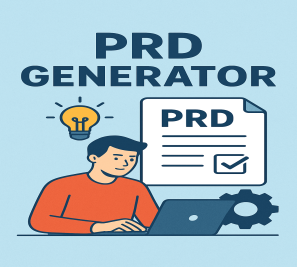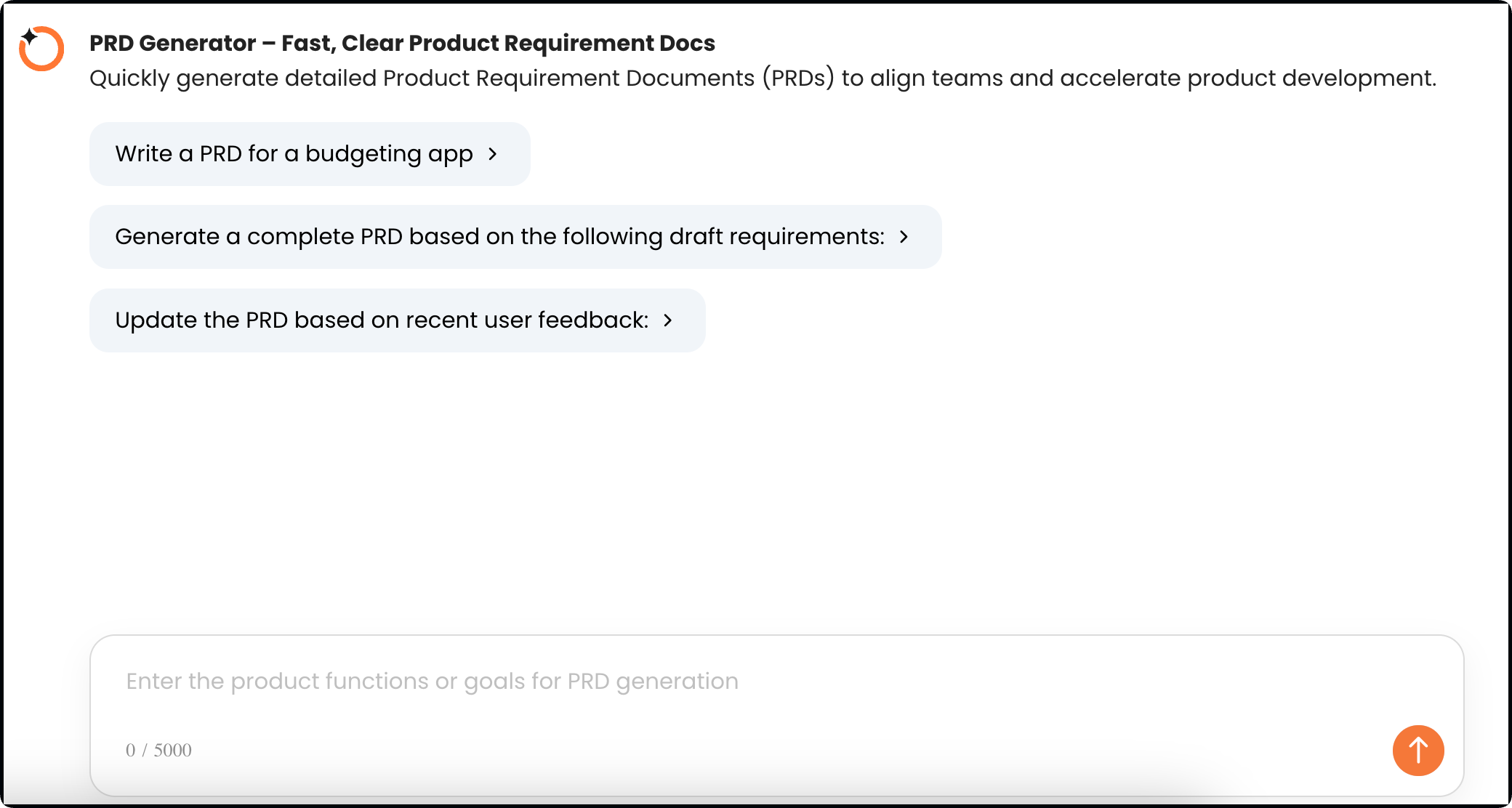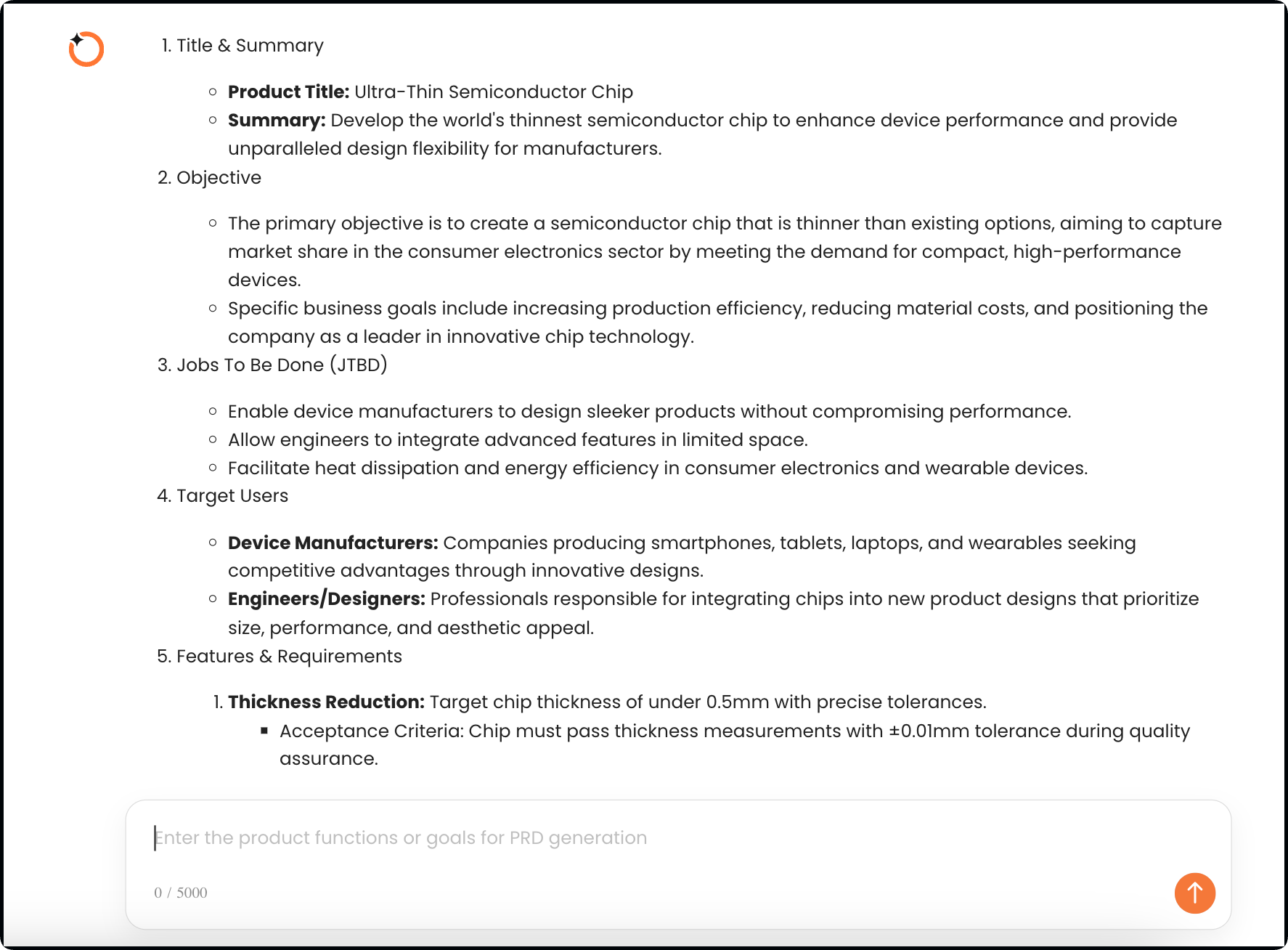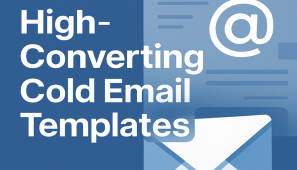Did you know that companies using an AI PRD generator can improve their product development process by up to 30%? In today’s fast-paced tech landscape, having the right tools is crucial for success.
As a product developer, you’re likely no stranger to the challenges of creating and managing product requirements. A PRD generator can be a game-changer, helping you streamline your workflow and ensure that all stakeholders are on the same page.
In this article, we’ll explore the top 20 AI PRD generators of 2025, comparing their key features and benefits. Whether you’re looking to simplify your product development process or enhance collaboration among your team, we’ve got you covered.
What Makes a Great PRD Generator in 2025?
What Is a PRD?
A Product Requirements Document (PRD) is a formal document that defines the product’s purpose, target audience, key features, and technical specifications. It acts as a blueprint for the product development team, ensuring everyone understands what needs to be built.
With advancements in AI and automation, AI PRD generators are becoming indispensable tools for product teams in 2025. The integration of AI PRD generator capabilities is enhancing the product development process, making it more efficient and accurate.
The Evolution of Product Requirements Documentation
The way product teams create and manage product requirements has undergone significant changes. Traditional methods of creating PRDs are being replaced by automated PRD automation tools that streamline the process.
Modern PRD generators have evolved to incorporate advanced features such as real-time collaboration, AI-driven suggestions, and seamless integration with other product development tools.
| Feature | Traditional PRD | Modern PRD Generators |
|---|---|---|
| Collaboration | Limited real-time collaboration | Real-time collaboration |
| Automation | Manual process | Automated AI PRD generation |
| Integration | Limited integration with other tools | Seamless integration with various tools |
Key Benefits of Using Modern AI PRD Maker Tools
Using modern PRD generators offers numerous benefits, including improved accuracy, faster decision-making, and enhanced collaboration among team members. These tools enable product teams to focus on developing high-quality products by automating mundane tasks.
The key benefits of modern PRD creators can be summarized as follows:
- Improved Accuracy: AI-driven suggestions reduce errors and improve the overall quality of PRDs.
- Faster Decision-Making: Real-time collaboration and AI-driven PRD generation enable teams to make decisions quickly.
- Enhanced Collaboration: Modern PRD generators facilitate seamless collaboration among cross-functional teams.
Essential Features to Look for in PRD Generators
To streamline your product development, you need a PRD generator with the right set of features. A well-chosen PRD generator can significantly enhance collaboration, integration, and overall efficiency in your product development process.
Collaboration Capabilities
Effective collaboration is crucial for successful product development. Look for a PRD generator that offers real-time commenting, @mentions, and task assignments to facilitate seamless teamwork. Collaboration capabilities ensure that all team members are on the same page, reducing misunderstandings and miscommunication.
Integration Options
A PRD generator that integrates with your existing tools can significantly reduce workflow disruptions. Consider a product documentation tool that supports integrations with popular project management and development tools. This ensures a smooth flow of information across different platforms.
(Click the picture to try Oreate AI PRD Generator⬆️)
Customization Flexibility
Every product team has unique needs, so it’s essential to choose a PRD generator that offers customization flexibility. This could include customizable templates, flexible workflows, and adjustable access permissions. A PRD template generator with these features allows you to tailor the tool to your specific requirements.
AI-Powered Assistance
The latest PRD generators are incorporating AI to assist with tasks such as requirement suggestions, document generation, and predictive analytics. An AI-powered PRD generator can help you anticipate potential issues, streamline your documentation process, and make data-driven decisions.
| Feature | Description | Benefit |
|---|---|---|
| Collaboration Capabilities | Real-time commenting, @mentions, task assignments | Enhanced teamwork and reduced miscommunication |
| Integration Options | Integrates with project management and development tools | Smooth information flow across platforms |
| Customization Flexibility | Customizable templates, workflows, access permissions | Tailored to specific team needs |
| AI-Powered Assistance | Requirement suggestions, document generation, predictive analytics | Streamlined documentation and data-driven decisions |
Best AI-Powered PRD Generators
In the rapidly evolving landscape of product development, AI-powered PRD generators stand out as game-changers. These innovative tools are transforming how product teams create, manage, and iterate on product requirements documents.
1. Notion AI
Notion AI is revolutionizing the way teams collaborate on product requirements. Its AI capabilities allow for dynamic documentation that adapts to your project’s needs. With features like real-time collaboration, customizable templates, and AI-driven suggestions, Notion AI is a powerful tool for modern product teams.
Features:
-
Real-time collaboration
-
Customizable templates
-
AI-driven content suggestions
-
Integrated task and project tracking
-
Adaptive document management
Pros:
-
Easy-to-use, clean interface
-
Extensive templates for quick setup
-
Combines documentation and task management
Cons:
-
Advanced AI features need a paid plan
-
May not scale well for very large projects
Best for: Small to medium teams
2. ProductBoard AI
ProductBoard AI brings a new level of sophistication to PRD generation. By integrating AI into its product management platform, ProductBoard enables teams to prioritize features, gather customer insights, and create detailed product roadmaps more efficiently. Its AI-driven analytics help in making informed decisions.
Features:
-
AI-driven PRD generation
-
Feature prioritization
-
Customer insights integration
-
Product roadmap creation
-
Data-driven analytics
Pros:
-
Professional product management focus
-
AI supports prioritization and decision-making
-
Strong analytics and insight integration
Cons:
-
Steeper learning curve
-
Higher cost
Best for: Medium to large product teams
3. Coda AI
Coda AI is another standout in the realm of AI-powered PRD generators. It combines the flexibility of a document with the power of a database, allowing teams to create customized PRDs that fit their specific needs. Coda AI’s AI capabilities facilitate smarter document creation and collaboration.
Features:
-
Document and database integration
-
AI-assisted content creation
-
Customizable templates
-
Collaboration and automation
-
Handles complex project structures
Pros:
-
Highly flexible and customizable
-
Supports complex data and workflows
-
Automation capabilities
Cons:
-
Interface can be complex for beginners
-
Learning curve for advanced features
Best for: Teams needing flexible, database-driven PRDs
To better understand the strengths of these AI-powered PRD generators, let’s compare their key features:
| Feature | Notion AI | ProductBoard AI | Coda AI |
|---|---|---|---|
| AI-Driven Suggestions | ✅ | ✅ | ✅ |
| Real-Time Collaboration | ✅ | ✅ | ✅ |
| Customizable Templates | ✅ | ✅ | ✅ |
| Integration with Other Tools | Extensive | Robust | Flexible |
4. Oreate AI PRD Generator
As an emerging star in PRD generation, Oreate AI PRD Generator is built to deliver fast, clear, and detailed Product Requirement Documents (PRDs) that help teams align quickly and move projects forward without delays. Whether you need to write a PRD for a budgeting app, a SaaS platform, or any other product, the generator adapts to your context and delivers a professional, easy-to-read document that meets industry standards.
Beyond initial creation, Oreate AI also excels at iterative updates, allowing you to modify an existing PRD in seconds based on recent user feedback or shifting business priorities. This agility keeps your documentation accurate and relevant throughout the development cycle, reducing miscommunication and ensuring everyone stays on the same page. By combining speed, clarity, and adaptability, Oreate AI PRD Generator not only accelerates product development but also strengthens collaboration between product managers, designers, developers, and stakeholders.
(Click the picture to try Oreate AI PRD Generator⬆️)
Features:
-
Fast, AI-driven PRD generation
-
Context-adaptive templates for different products
-
Industry-standard, easy-to-read documents
Pricing: Totally free
Pros:
-
Quick and efficient PRD creation
-
Produces professional, standardized documents
-
Adaptable to various product types
Cons:
-
May lack integrations compared to larger platforms
Best for: Teams needing fast, professional PRDs without heavy setup or manual formatting.
Top PRD Template Generators for Startups
For startups looking to optimize their product development workflow, the right PRD template generator is crucial. These tools help streamline the process of creating product requirements documents, making it easier for teams to collaborate and bring products to market faster.
When selecting a PRD template generator, startups should consider factors such as ease of use, customization options, and integration with existing tools. Here are 3 top recommendations:
1. Aha! Roadmaps
Aha! Roadmaps is a comprehensive product development platform that includes a robust PRD template generator. It allows startups to create detailed product roadmaps, prioritize features, and track progress in one place.
- Create customizable PRD templates tailored to your startup’s needs
- Integrate with popular tools like Jira, Trello, and Slack
- Collaborate with team members in real-time
Pros:
-
Comprehensive platform for product planning
-
Strong integrations with popular tools
-
Suitable for growing startups needing structured roadmaps
Cons:
-
Can be complex for very small teams
-
Cost may be high for early-stage startups
Best for: Startups and product teams
2. Craft.io
Craft.io is another powerful PRD template generator designed for product teams. It offers advanced features like AI-driven product management and customizable templates.
Pros:
-
Flexible and customizable
-
Advanced product management features
-
Focused on team collaboration
Cons:
-
Learning curve for new users
-
Cost may be a factor for smaller teams
Best for: Product teams seeking AI-enhanced PRD creation and workflow management.
| Feature | Aha! Roadmaps | Craft.io |
|---|---|---|
| Customizable Templates | ✅ | ✅ |
| AI-Driven Features | ❌ | ✅ |
| Integration Options | Jira, Trello, Slack | Jira, Asana, Slack |
3. Asana
Asana is a popular project management tool that also offers PRD template generation capabilities. It’s particularly useful for startups looking to manage their product development workflow within a single platform.
- Create and assign tasks related to product development
- Track progress and deadlines
- Integrate with other tools like GitHub and Jira
Pros:
-
Easy to use and widely adopted
-
Combines project management and PRD templates in one platform
-
Strong integrations with developer tools
Cons:
-
PRD features are secondary to task management
-
Limited customization compared to dedicated PRD tools
Best for: Startups or small teams
By leveraging these PRD template generators, startups can significantly improve their product development process, enhancing collaboration and productivity.
PRD Generators with Robust Collaboration Features
Effective collaboration is crucial for product teams, and the right PRD generator can make all the difference. In today’s fast-paced product development environment, teams need tools that not only help them create detailed product requirements but also facilitate seamless collaboration.
When evaluating PRD generators, it’s essential to consider their collaboration features. The ability to work together in real-time, share feedback, and track changes is vital for successful product development. Let’s explore some of the top PRD generators known for their robust collaboration capabilities.
1. Confluence
Confluence is a popular choice among product teams due to its comprehensive collaboration features. It allows teams to create, share, and store product requirements in a centralized location. With Confluence, you can:
- Collaborate in real-time with team members
- Track changes and revisions
- Integrate with other Atlassian tools like Jira
Confluence stands out for its ability to integrate with other tools in the Atlassian ecosystem, making it a powerful choice for teams already using Jira or other Atlassian products.
2. Fibery
Fibery is another PRD generator that excels in collaboration. It offers a flexible and customizable platform that adapts to your team’s workflow. Key features include:
- Customizable workflows to fit your team’s needs
- Real-time collaboration and commenting
- Integration with various third-party tools
Fibery’s flexibility and customization options make it an attractive choice for teams looking for a tailored solution that fits their specific collaboration needs.
Both Confluence and Fibery demonstrate the importance of collaboration in PRD generators. By leveraging these tools, product teams can enhance their productivity and streamline their product development process.
When choosing a PRD generator, consider the collaboration features that are essential to your team’s workflow. Look for tools that offer real-time collaboration, customizable workflows, and seamless integration with other tools you use.
PRD Generator Tools for Enterprise Teams
PRD automation is becoming a necessity for enterprise teams looking to reduce manual errors and improve productivity. As product development cycles become increasingly complex, the need for efficient and accurate product requirements documentation (PRD) has never been more critical.
Enterprise teams are benefiting from advanced PRD automation tools that leverage AI to streamline the documentation process. These tools not only reduce the time spent on creating and updating PRDs but also enhance collaboration among team members.
1. Jira Product Discovery
Jira Product Discovery is a powerful tool designed to help product teams prioritize and manage their product roadmaps more effectively. It integrates seamlessly with Jira, allowing teams to link product requirements directly to development tasks.
Key Features of Jira Product Discovery:
- AI-driven prioritization
- Integration with Jira
- Real-time collaboration
2. Airfocus
Airfocus is another robust PRD automation tool that offers a wide range of features to support product teams. Its AI capabilities help in analyzing market trends and customer feedback to inform product decisions.
Key Features of Airfocus:
- AI-powered insights
- Customizable roadmaps
- Integration with various tools
Both Jira Product Discovery and Airfocus are transforming how enterprise teams approach product requirements documentation. By automating routine tasks, these tools enable teams to focus on strategic product decisions.
| Tool | AI Capabilities | Integration | Collaboration Features |
|---|---|---|---|
| Jira Product Discovery | AI-driven prioritization | Jira integration | Real-time collaboration |
| Airfocus | AI-powered insights | Multiple integrations | Customizable roadmaps |
(Click the picture to try Oreate AI PRD Generator⬆️)
By adopting these PRD automation tools, enterprise teams can significantly improve their product development processes, making them more efficient and responsive to market needs.
Free and Open-Source PRD Generators
Free and open-source PRD generators offer a cost-effective solution for product teams looking to streamline their requirements documentation process. These tools provide the flexibility and transparency that teams need without the hefty price tag associated with premium solutions.
Two notable examples of free and open-source PRD generators are GitLab Product Planning and Trello PRD Templates. Let’s dive into what each has to offer.
1. GitLab Product Planning
GitLab Product Planning is a robust tool that integrates product planning with development workflows. It allows teams to manage their product requirements directly within the GitLab environment, facilitating a seamless transition from planning to development.
Key Features of GitLab Product Planning:
- Integrated issue tracking and project management
- Version control and collaboration features
- Customizable workflows to suit team needs
2. Trello PRD Templates
Trello PRD Templates offer a flexible and user-friendly way to manage product requirements. Trello’s card-based system allows teams to organize and prioritize their work visually, making it easier to collaborate and track progress.
Benefits of Trello PRD Templates:
- Highly customizable boards and cards
- Integration with various third-party apps
- Visual project management for enhanced collaboration
Here’s a comparison of GitLab Product Planning and Trello PRD Templates:
| Feature | GitLab Product Planning | Trello PRD Templates |
|---|---|---|
| Integration | Tight integration with GitLab development environment | Wide range of third-party integrations |
| Customization | Customizable workflows and issue tracking | Highly customizable boards and cards |
| Collaboration | Version control and collaboration features | Visual project management for enhanced collaboration |
Both GitLab Product Planning and Trello PRD Templates offer unique strengths that can cater to different team needs. By leveraging these free and open-source PRD generators, product teams can enhance their documentation process, improve collaboration, and ultimately drive project success.
PRD Generators with Advanced Analytics
Product teams are now leveraging PRD generators with advanced analytics to gain deeper insights into their products. These tools are not just about creating product requirements documents; they’re about providing valuable data that can inform product decisions.
As we mentioned above, Productboard is a powerful tool for analytics. here, we’ll explore another prominent PRD generators that stand out for its advanced analytics capabilities: Pendo.
Pendo
Pendo is another powerful PRD generator that offers advanced analytics features. With Pendo, you can:
- Gain insights into user behavior and adoption
- Track product usage and identify areas for improvement
- Make informed decisions with data-backed insights
Pendo’s analytics capabilities provide a comprehensive view of your product’s performance, enabling you to optimize your product and drive growth.
(Click the picture to try Oreate AI PRD Generator⬆️)
Then, how to choose from these two? Here’s a comparison of Productboard and Pendo’s advanced analytics features:
| Feature | Productboard | Pendo |
|---|---|---|
| Customer Feedback Analysis | ✅ | ✅ |
| User Behavior Tracking | ✅ | ✅ |
| Product Usage Insights | ✅ | ✅ |
| Customizable Dashboards | ✅ | Limited |
Both Productboard and Pendo offer robust advanced analytics features that can help product teams make data-driven decisions. By leveraging these tools, you can gain a deeper understanding of your product’s performance and drive growth.
Best PRD Generators for User-Centered Design
For teams focused on user-centered design, selecting the right PRD generator is crucial for success. A good PRD generator should facilitate collaboration, creativity, and intuitive design processes.
When it comes to user-centered design, tools like Miro PRD Templates and Figma PRD Templates are leading the way. These PRD generators offer a range of features that cater to the needs of design teams.
1. Miro PRD Templates
Miro is a popular choice among design teams due to its collaborative and visual approach to product development. Its PRD templates offer a structured yet flexible way to manage product requirements.
- Visual collaboration tools
- Customizable templates
- Integration with other design tools
2. Figma PRD Templates
Figma is another powerful tool that has gained widespread adoption in the design community. Its PRD templates are designed to streamline the product development process, making it easier to collaborate and iterate on designs.
- Real-time collaboration
- Cloud-based platform
- Extensive plugin ecosystem
Both Miro and Figma offer robust PRD template generators that can significantly enhance the user-centered design process. By leveraging these tools, teams can improve collaboration, reduce misunderstandings, and create products that better meet user needs.
When choosing a PRD generator for user-centered design, consider the specific needs of your team, including the level of collaboration required, the type of projects you work on, and the tools you already use.
PRD Generators for Agile Development Teams
For agile teams, the right PRD generator can make all the difference in delivering high-quality products quickly. Agile development methodologies demand flexibility, responsiveness, and collaboration, making the choice of PRD generator crucial.
Agile teams require tools that can support their iterative and adaptive workflows. PRD generators like Monday.com and ClickUp are designed to meet these needs, offering features that enhance collaboration, flexibility, and responsiveness to change.
1. Monday.com
Monday.com is a popular PRD generator that supports agile development teams by providing a customizable and collaborative platform. Its key features include:
- Customizable workflows to fit your team’s needs
- Real-time collaboration and communication
- Integration with other tools and services
2. ClickUp
ClickUp is another powerful PRD generator that caters to agile teams. It offers a range of features that support agile methodologies, including:
- Task management and prioritization
- Customizable dashboards and reporting
- Integration with other agile tools
Both Monday.com and ClickUp provide agile teams with the flexibility and responsiveness they need to deliver high-quality products. By automating PRD processes, these tools help teams focus on what matters most – developing great products.
| Feature | Monday.com | ClickUp |
|---|---|---|
| Customizable Workflows | ✅ | ✅ |
| Real-time Collaboration | ✅ | ✅ |
| Integration Options | Multiple integrations | Multiple integrations |
| Task Management | ✅ | ✅ |
When choosing a PRD generator for your agile team, consider the specific needs of your team and the features that are most important to you. By selecting the right tool, you can enhance your team’s productivity and responsiveness.
Specialized PRD Generators for Specific Industries
As product development becomes increasingly complex, specialized PRD generators are emerging to cater to specific industry needs. These tools are designed to address the unique challenges and requirements of various sectors, providing more effective product development processes.
You might be wondering how these specialized PRD generators can benefit your product team. By tailoring the product requirements documentation process to your industry’s specific needs, you can streamline your development workflow and improve collaboration among team members.
1. Xtensio
Xtensio is a PRD generator that has gained recognition for its ability to cater to the needs of specific industries. By providing customizable templates and industry-specific features, Xtensio enables product teams to create detailed product requirements documents that meet their unique needs.
One of the key benefits of using Xtensio is its flexibility. You can tailor the tool to your industry’s specific requirements, ensuring that your product development process is aligned with your business goals.
Features:
-
Customizable templates for different industries
-
Flexible PRD creation to match business requirements
-
Easy alignment of product development with company goals
Pros:
-
Highly flexible and adaptable to industry needs
-
Helps ensure product development aligns with business objectives
-
User-friendly interface
Cons:
-
Advanced features require a subscription
-
May not have as many integrations as larger platforms
2. Slite
Slite is another example of a PRD generator that is making waves in the industry. With its AI-powered features and collaborative capabilities, Slite is well-suited for product teams looking to streamline their product development process.
Slite’s strength lies in its ability to facilitate collaboration among team members. By providing a centralized platform for product requirements documentation, Slite enables you to work more efficiently with your team, ensuring that everyone is on the same page throughout the product development process.
Features:
-
AI-assisted PRD creation
-
Centralized platform for team collaboration
-
Real-time editing and document sharing
Pros:
-
Excellent for team collaboration and knowledge sharing
-
Centralized documentation keeps everyone aligned
-
Simple and intuitive interface
Cons:
-
AI capabilities may be less advanced than specialized PRD tools
-
Limited customization compared to dedicated PRD platforms
Why Oreate AI Is the Smartest PRD Generator for Product Teams?
For product teams seeking a smart PRD generator, Oreate AI is the go-to solution that combines AI-driven insights with intuitive collaboration tools. As an AI PRD generator, Oreate AI is designed to simplify the product development process by a single click, making it more efficient and streamlined.
(Click the picture to try Oreate AI PRD Generator⬆️)
Oreate AI stands out in the market due to its advanced features and user-centric approach. By leveraging PRD automation, teams can focus more on product innovation rather than getting bogged down in documentation.
Key Features of Oreate AI
Oreate AI boasts several key features that make it an indispensable tool for product teams:
- No sign-up required and free of charge
- AI-driven insights to enhance product development
- Customizable output to fit your team’s needs
- Intuitive interface, friendly for beginner teams
- High-quality output by a few inputs
- Instant feedback
These features collectively contribute to Oreate AI’s status as a top-tier AI PRD generator, enabling teams to work more effectively and efficiently.
How to Get Started with Oreate AI PRD generator?
Getting started with Oreate AI is straightforward:
Step 1. Visit Oreate AI platform and find New Project>AI Toolbox>PRD Generator.
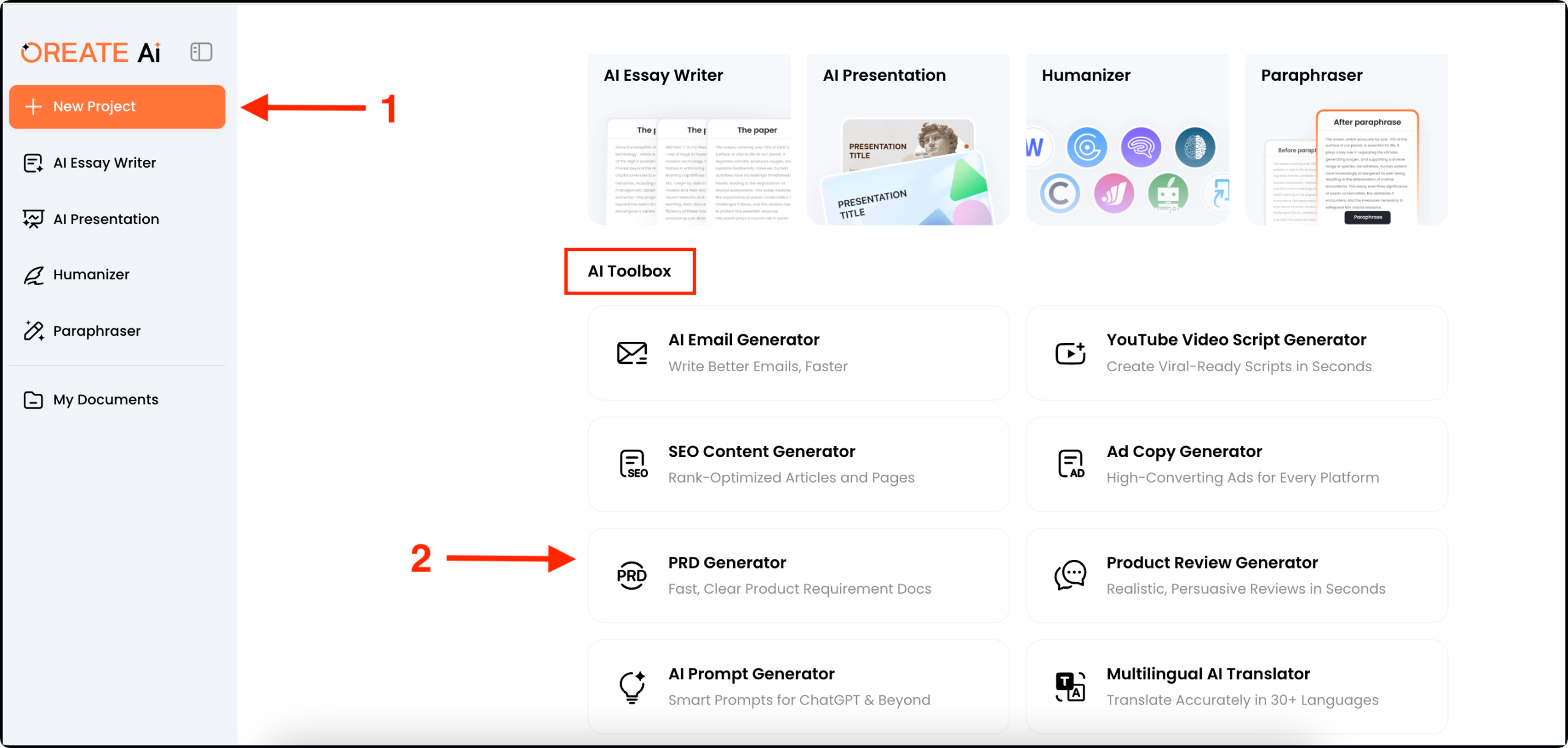
Step 2. Input what you want and the agent will give you the feedback instantly.
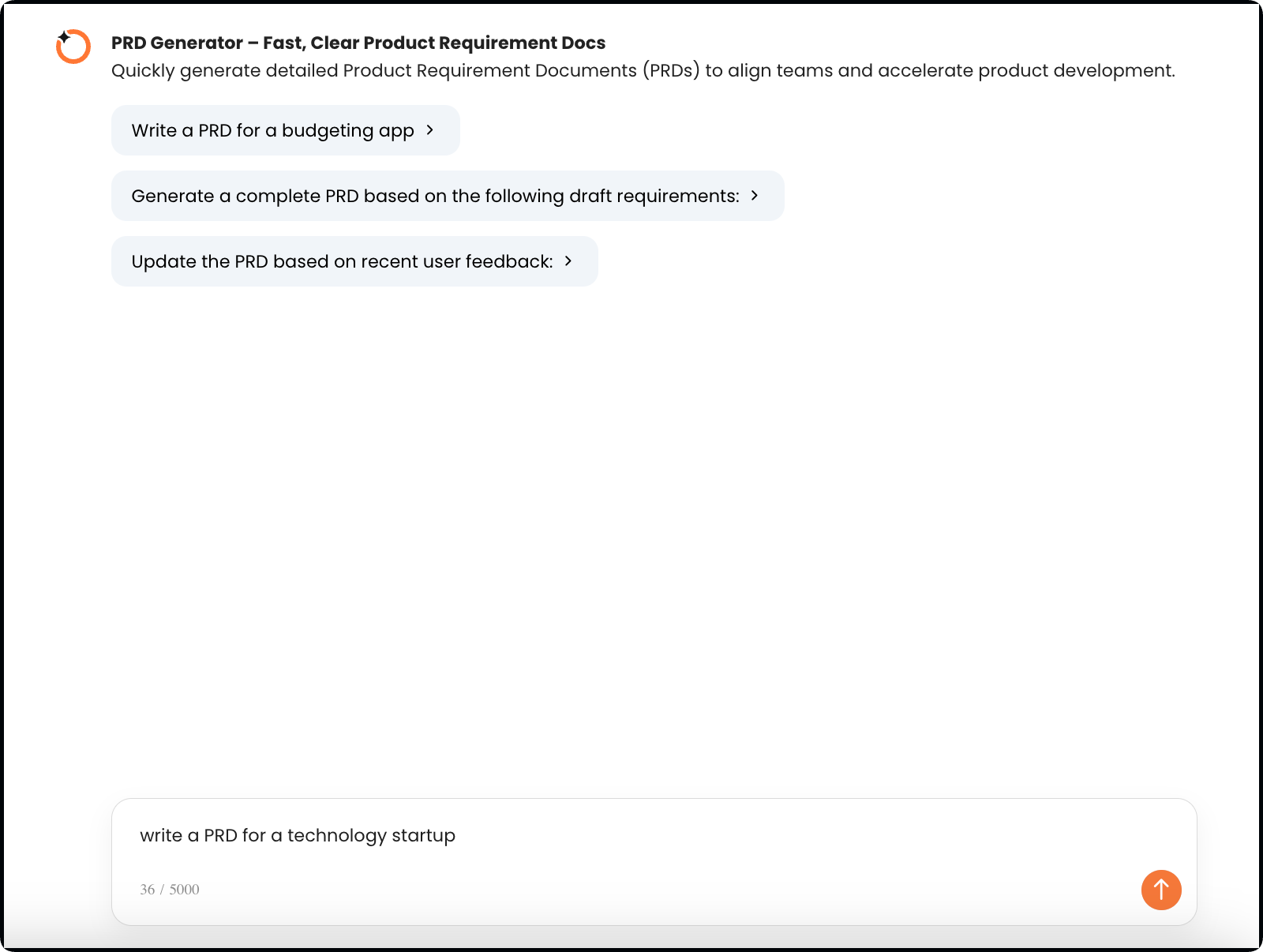
Step 3. Give more customized prompts to better fit for your brand.
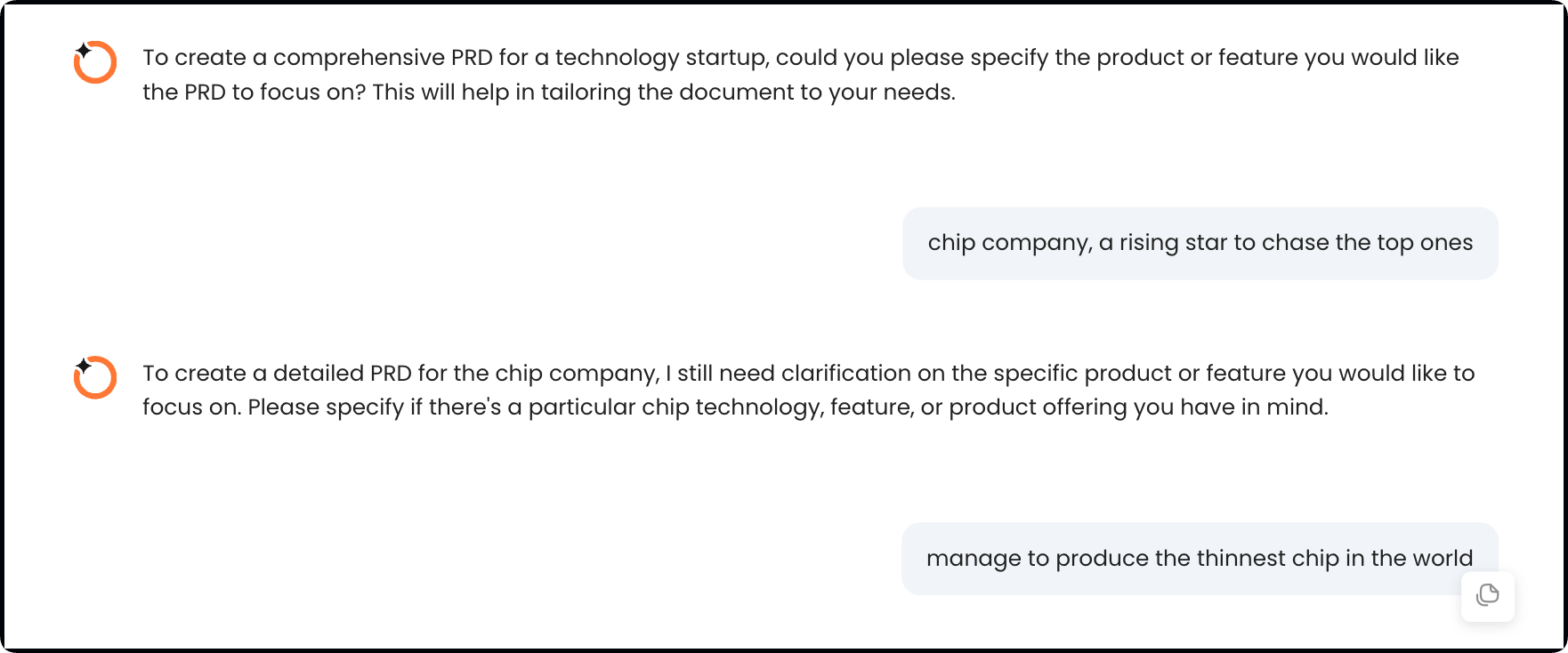
Step 4. Review the output and start working on your PRD.
(Click the picture to try Oreate AI PRD Generator⬆️)
By following these simple steps, you can begin leveraging the power of Oreate AI for your product team, enhancing your product development process with PRD automation and AI-driven insights.
How to Choose the Right PRD Generator for Your Needs?
With numerous PRD generators available, selecting the best one can be overwhelming. To make an informed decision, you need to consider several factors that align with your team’s specific requirements.
Assessing Your Team’s Requirements
Start by evaluating your team’s workflow and identifying the features that are essential for your product development process. Consider the type of projects you handle, the size of your team, and the collaboration features you need. A PRD generator that supports your team’s workflow will significantly enhance productivity.
Considering Budget and Scalability
Your chosen PRD generator should fit within your budget and scale with your growing needs. Some tools offer a free version or trial, while others require a subscription. Evaluate the costs and consider whether the tool can adapt to your expanding requirements. A scalable product documentation tool will save you from migrating to a new platform in the future.
Evaluating Learning Curve and Support
The usability of a PRD generator is crucial. Opt for a tool that is intuitive and has a gentle learning curve. Additionally, consider the level of customer support provided, including documentation, tutorials, and customer service. Effective support will help your team get up to speed quickly.
| Feature | Importance | Score (1-5) |
|---|---|---|
| Collaboration | High | 4 |
| Scalability | Medium | 3 |
| Customer Support | High | 5 |
By carefully assessing your team’s requirements, considering budget and scalability, and evaluating the learning curve and support, you can choose a PRD generator that meets your needs and enhances your product development process.
Common Mistakes to Avoid When Using PRD Generators
As you integrate PRD template generators into your workflow, be aware of the common mistakes that can impact your outcomes. PRD automation can significantly enhance your product development process, but only if used correctly. 2 critical errors to watch out for are overcomplicating requirements and neglecting stakeholder input.
Overcomplicating Requirements
One of the most significant mistakes you can make when using a PRD generator is overcomplicating your requirements. This can lead to confusion among team members and stakeholders, ultimately slowing down your project. To avoid this, keep your requirements clear and concise. Use simple language and focus on the essential features of your product. Avoid unnecessary jargon and technical terms that might confuse non-technical stakeholders.
Neglecting Stakeholder Input
Another critical mistake is neglecting stakeholder input. Your PRD generator is only as good as the information you put into it. Engage with your stakeholders to ensure that their needs and expectations are captured accurately. This includes not just the product team but also customers, sales representatives, and other relevant parties. By doing so, you’ll create a more comprehensive and effective product requirements document.
| Mistake | Impact | Solution |
|---|---|---|
| Overcomplicating Requirements | Confusion among team members, delayed projects | Simplify language, focus on essential features |
| Neglecting Stakeholder Input | Incomplete or inaccurate PRD | Engage with stakeholders, capture their needs |
Conclusion
As you navigate the world of product development, selecting the right PRD generator can significantly enhance your team’s efficiency and productivity. With the numerous options available, it’s essential to consider your specific needs and requirements.
The AI PRD generators listed in this article offer a range of features and capabilities to streamline your product development process. From Notion AI to Oreate AI, each tool has its unique strengths and weaknesses. By understanding your team’s requirements and exploring these options, you can find the perfect PRD generator to suit your needs.
When choosing a PRD generator, consider factors such as collaboration capabilities, integration options, and customization flexibility. By doing so, you’ll be able to identify the tool that best aligns with your product team’s workflow, ultimately leading to improved product development outcomes.
FAQs
1. Are AI PRD Generators free to use?
Some AI PRD Generators are partially free, while advanced features usually require a subscription. For example, Oreate AI offers a free version with no sign-up required—perfect for testing it out.
2. Do I need technical skills to use an AI PRD Generator?
No. Most AI PRD Generators are designed for product managers, designers, and team members without technical backgrounds. They include intuitive interfaces, templates, and AI suggestions to simplify PRD creation.
3. How do AI PRD Generators compare to traditional PRD creation?
AI PRD Generators are faster, reduce manual errors, and provide AI-driven insights. Traditional PRD creation is manual, slower, and relies heavily on team experience and collaboration.
4. Are AI PRD Generators secure for sensitive product information?
Reputable tools use encryption and secure cloud storage. Always check the provider’s privacy policy, and for highly sensitive projects, consider enterprise plans with enhanced security features.
